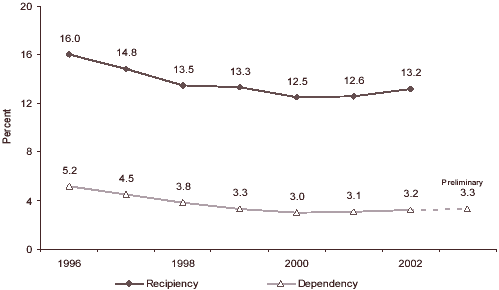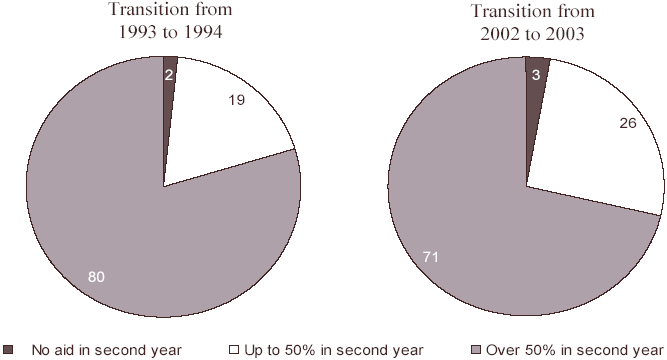| About this Research Brief This ASPE Research Brief summarizes the findings from an annual report to Congress reporting the extent to which American families depend on income from welfare programs. The report provides welfare dependence indicators through 2002, reflecting changes that have taken place since enactment of the Personal Responsibility and Work Opportunity Reconciliation Act (PRWORA) in August 1996. |
"In 2002, 3.2 percent of the total population was considered dependent because they received more than half of their total family income from TANF, food stamps, and/or SSI. This rate is marginally higher than the 3.1 percent dependency rate measured in 2001. Overall, 4.7 million fewer Americans were dependent on welfare in 2002 than in 1996, the year of passage of the Personal Responsibility and Work Opportunity Reconciliation Act. Poverty rates have also declined since 1996. Since 1996, food stamp and TANF receipt have decreased significantly, while SSI receipt has remained stable. Recipients of means-tested assistance were more likely to move out of dependency in the early 2000s than in the early 1990s. About three-tenths (29 percent) of recipients who received more than 50 percent of their total income from means-tested assistance programs in 2002 transitioned out of this dependency status in 2003.
Introduction
The Welfare Indicators Act of 1994 requires the Department of Health and Human Services to prepare annual reports to Congress on the extent to which American families depend on income from welfare programs. In response, the Secretary of Health and Human Services (HHS) publishes an annual report, which provides indicators and predictors of welfare dependence. This research brief summarizes the findings from the eighth annual report in the series, which reflects changes that have taken place since enactment of the Personal Responsibility and Work Opportunity Reconciliation Act (PRWORA) in August 1996 and provides updated measures through 2002.
Measuring Welfare Dependence
The Welfare Indicators Act specified that analyses of means-tested assistance should include benefits from the following three programs:
- The Aid to Families with Dependent Children (AFDC) program, the cash assistance program serving the largest number of persons, provided monthly cash benefits to families with children, until its replacement by the Temporary Assistance for Needy Families (TANF) program, which is operated directly by the states.
- The Food Stamps Program provides monthly food stamp benefits to individuals living in families or alone, provided their income and assets are below limits set in Federal Law. It reaches more poor people over the course of a year than any other means-tested assistance program.
- The Supplemental Security Income (SSI) program provides monthly cash payments to elderly, blind, or disabled individuals or couples whose income and assets are below levels set in Federal Law. Though a majority of recipients are adults, disabled children also are eligible.
Welfare dependence, like poverty, is a continuum, with variations in degree and in duration. Families may be more or less dependent if larger or smaller shares of their total resources are derived from welfare programs. The amount of time over which families depend on welfare might also be considered in assessing their degree of dependence. Although recognizing the difficulties inherent in de.ning and measuring dependence, a bipartisan Advisory Board on Welfare Indicators proposed the following definition, as one measure to examine in concert with other key indicators of dependence and well-being:
A family is dependent on welfare if more than 50 percent of its total income in a one-year period comes from AFDC/TANF, food stamps and/or SSI, and this welfare income is not associated with work activities. Welfare dependence is the proportion of all families who are dependent on welfare.
Highlights of Report
In 2002, 3.2 percent of the population would be considered “dependent” on welfare under the above definition. This is about one-quarter of the percentage (13.2 percent) that lived in a family receiving at least some TANF, food stamps, or SSI benefits during the year. Although data are not yet available to show a clear trend in the dependency rate through 2003, available data suggest the rate may increase slightly between 2002 and 2003.(1)
However, even when considering the small increases since 2000, dependency and recipiency rates remained significantly lower than the 1996 rates, as shown in Figure 1. While 13.74 million individuals were dependent in 1996, only 9.03 million were dependent in 2002 — representing a decline of 4.7 million people.
Figure 1.
Recipiency and Dependency Rates: 1996-2002

Source: Unpublished tabulations from the Current Population Survey, Annual Social and Economic Supplement, 1997-2003,
analyzed using the TRIM3 microsimulation model.
Trends in dependency are similar to the more well-known changes in TANF and food stamps caseloads. For example, the percentage of individuals receiving AFDC/TANF cash assistance fell from 4.6 percent to 1.9 percent between 1996 and 2003, as shown in Figure 2. Food stamp recipiency rates fell from 9.5 percent in 1996 to 6.1 percent in 2000 and 2001. Since then, the food stamp recipiency rate has increased to 7.3 percent in 2003. This increase in food stamp recipiency may explain the modest increase in overall dependency since 2000.
Figure 2.
Percentage of Total Population Receiving Food Stamps, TANF, or SSI, 1980-2003

Source: Department of Health and Human Services, Administration for Children and Families, Office of Family Assistance, and
U.S. Bureau of the Census (available online at http://www.census.gov) model.
To assess the social impacts of any change in dependence, changes in the level of poverty should be considered. Poverty in 2003 (12.5 percent) was lower than in 1996 (13.7 percent). This difference indicates that 668 thousand fewer people were in poverty and 1.6 million fewer children were in families with incomes below the poverty line than in 1996. There was an increase in the overall and child poverty rates between 2000 and 2003, but the poverty rate among adults over age 64 remained essentially unchanged.
Length of Dependency
Another important aspect of welfare dependency is the length of time families stay dependent on welfare. Of the families who received more than 50 percent of their total income from AFDC/TANF, food stamps, and/or SSI in 2002, 71 percent were still dependent in 2003. As shown in Figure 3, recipients of means-tested assistance were more likely to move out of dependency in the early 2000s than in the early 1990s. About three-tenths (29 percent) of recipients who received more than 50 percent of their total income from means-tested assistance programs in 2002 transitioned out of this dependency status in 2003.

Source: Unpublished tabulations from the Survey of Income and Program Participation, 1993 and 2001 panels.
Conclusion
This brief has highlighted key findings on welfare dependence. A copy of the full report, Indicators of Welfare Dependence (2005), with these and many other indicators and risk factors of dependency, can be found at http://aspe.hhs.gov/hsp/indicators05.
1. While TRIM-adjusted CPS data for 2003 are not yet available, estimates from the Survey of Income and Program Participation, as well as non-adjusted estimates from the Annual Social and Economic Supplement to the CPS, indicate a slight increase in the level of dependence between 2002 and 2003.
Michael J. O’Grady, Ph.D.
Assistant Secretary for Planning and Evaluation (ASPE)
Barbara B. Broman
Acting Deputy Assistant Secretary for Human Services Policy
